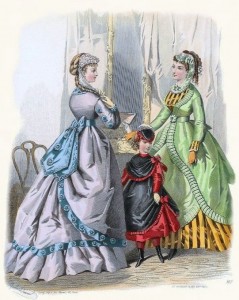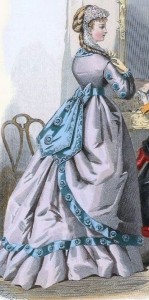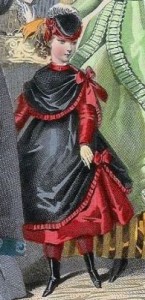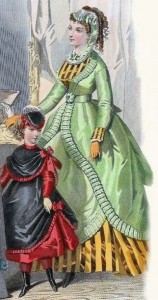Friday’s Fashion Plates: 1869 Visiting Dresses
Here is a fashion plate from an 1869 issue of The Englishwoman’s Domestic Magazine. It contains two visiting dresses, one of which uses a remarkable color combination.
The Victorians were not shy when it came to colors. The invention of aniline dyes in 1855 initiated a frenzy to produce ever bolder, brighter colors. Women often wore two or three different colors together, sometimes with startling results, as shown here.
In 1869, fashion was transitioning between the hoopskirt and the early bustle. Thus, the skirt is full and bell-shaped, but not nearly as wide as in previous years. The emphasis has shifted to the back. Both women likely wear wire crinolines to provide the right shape. You can see the beginnings of the layered styles of the 1870s in the front apron and bustled overskirts of the two dresses.
Left
On the left is a woman wearing a dress of lavender-gray trimmed with sky blue. It has a wide blue collar, narrow cuffs, and a belt with large sash ends in the back. The overskirt is split in the back, revealing a plain skirt with a lightly gathered ruffle at the bottom. The dress is decorated with fabric rosettes; they top the ruffle, edge the overskirt, and are visible around the collar, down the back of the sleeves, around the cuffs, and on the sash.
She wears no jewelry, just pale yellow gloves. Her hair is worn up, with a curly fringe at her forehead and long sausage curls down the back. Crowning her chignon is a lace cap or bonnet.
Center
In the middle is a young girl dressed for an afternoon of visiting. Her plain red dress is just below knee-length with a bell-shaped skirt. She wears an overskirt of black that is caught up at the side with a little red bow. Her bodice is covered by a black capelet that similarly features a bow at the shoulder. Both the capelet and the overskirt are edged with a narrow row of red pleats. Peeking out from under the capelet, you can see that her bodice has a high mandarin collar and long, tight sleeves.
She wears a fashionably tilted black hat that’s trimmed in red and accented with a single white feather. Her stockings are dark red, her boots are black, and her gloves appear to be cream-colored.
Right
The woman on the right wears a gold and brown striped silk visiting dress with a shorter mint green overdress. The neckline of the striped dress is high and the sleeves are long and tight. The overdress appears to be cut in a simple princess-style, meaning it’s all one piece, instead of a separate skirt and bodice, and it’s open to the waist, revealing the bodice of the striped dress underneath. The sleeves are bracelet-length, which allows the longer striped sleeves to show at the wrists. A narrow ruffle peeks out from under the cuffs. The skirt of the overdress is split, with a long, matching apron underneath. A pleated ruffle edges the dress, accompanied by a matching belt that’s accented by a fabric flower. There appears to be a large bow that ties in the back, with a sash that falls halfway down the skirt.
She wears matching gold-colored gloves and no jewelry. Her hair is pulled up with a mass of ringlets falling down the back; she wears a small bonnet covered with matching green ribbon and narrow lace.
~~*~~
What do you think of these dresses? Are the colors perfectly Victorian—or far too bold?





I don’t think the girl is wearing gloves at all.
Granted, I’m not an expert in the lost art of Victorian fashion plate drawing, but there’s two ways to tell if the girl is wearing gloves here. See the three lines on the back of her hand? Those are decorative pintucks that were common on Victorian gloves. You can also check the color. Compare the pale yellow of her hands with the pinkish tones of her face. It’s the same for the lady on the left, her hands are a different color than her face, which indicates gloves.